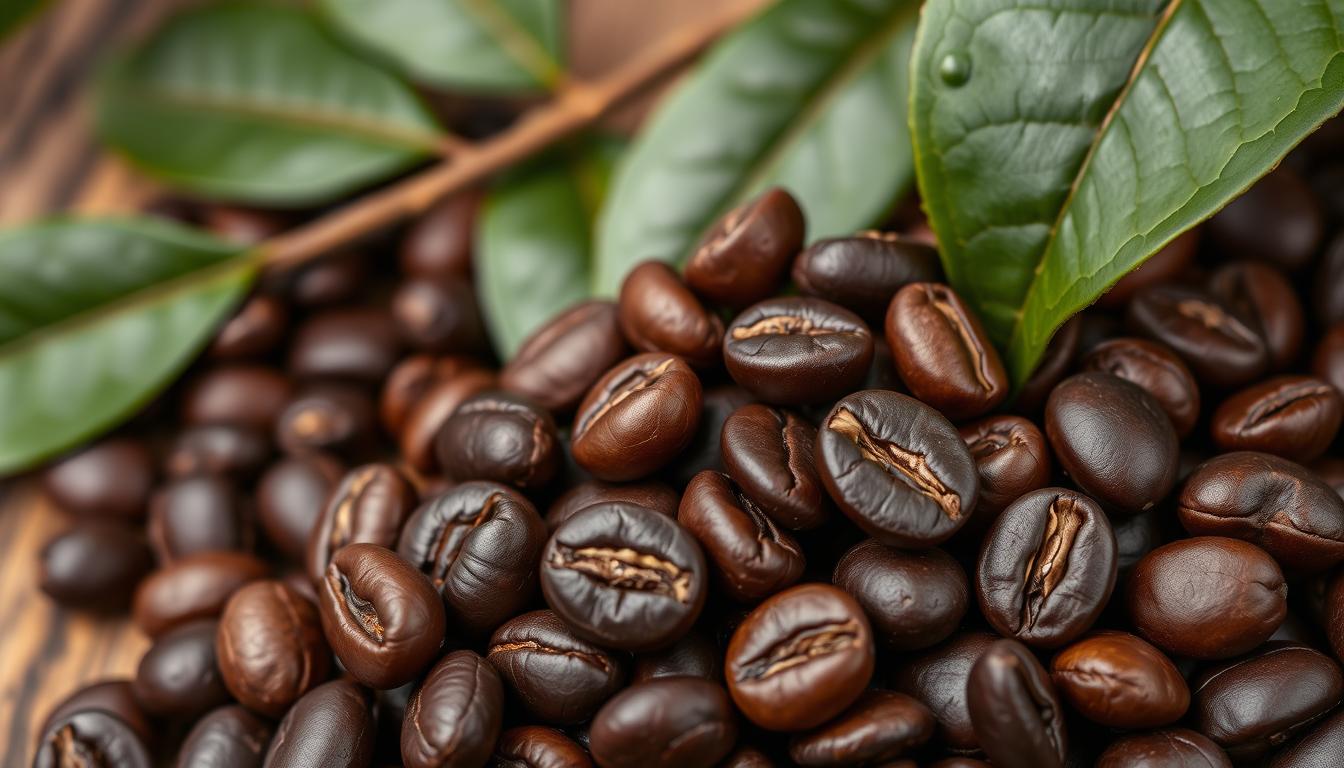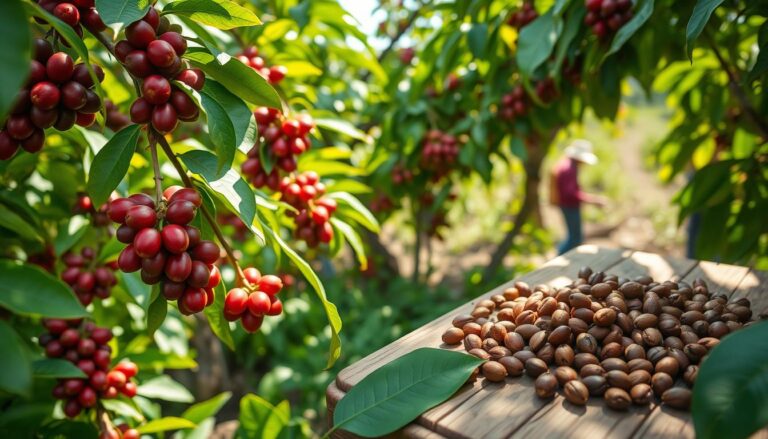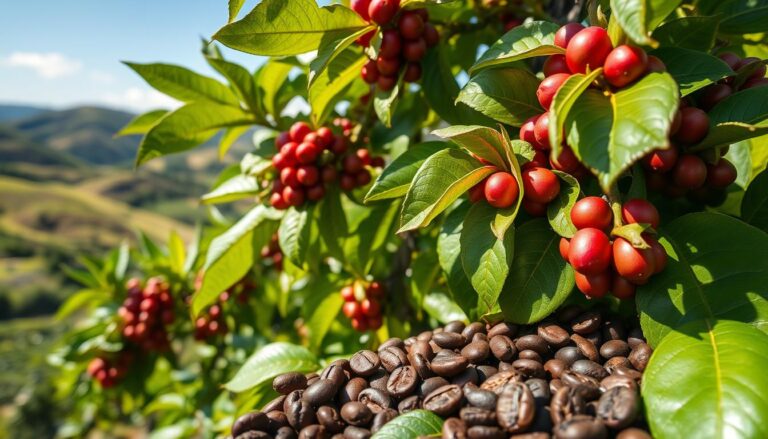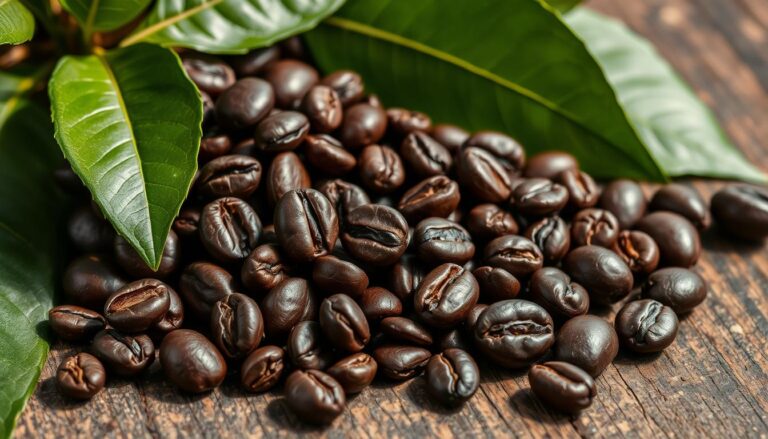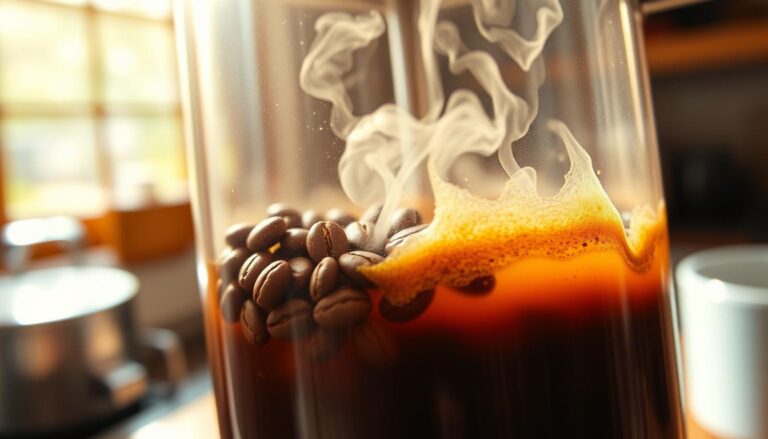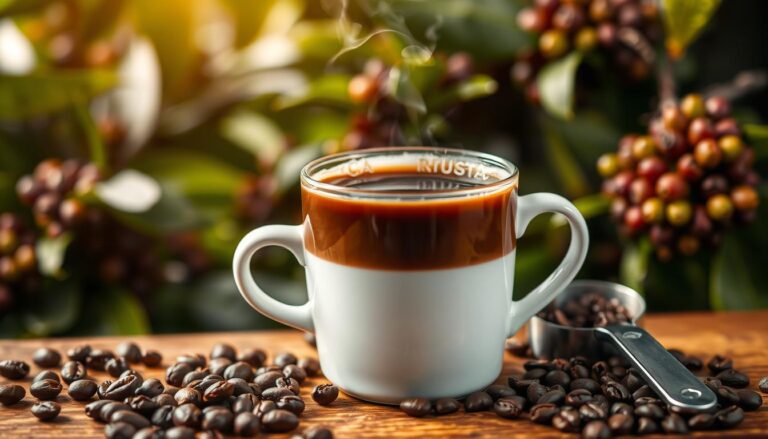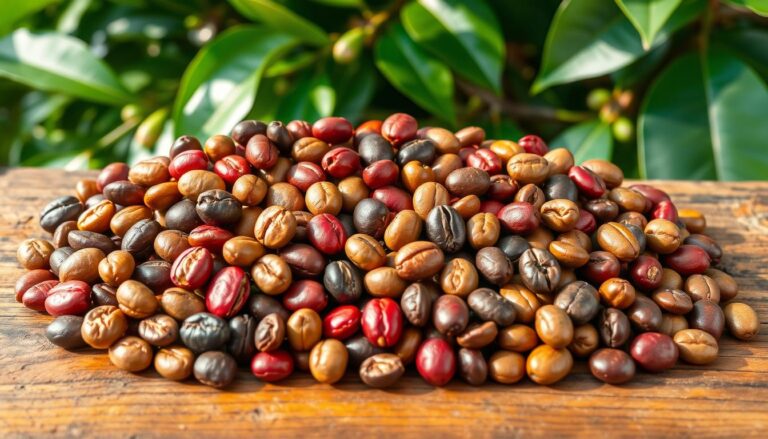Ever wondered what makes Sumatra coffee so special? As a coffee lover, I found out it’s a mix of taste, tradition, and place.
Sumatra, in Indonesia, is a mix of Arabica and Robusta beans. It tells a story of farming history. This island’s coffee is different from others around the world.
Sumatra coffee is only 8% of Indonesia’s coffee, but it’s 30% of the country’s coffee exports. This shows how much people love these unique beans.
The island’s soil, climate, and how they make coffee are all special. Sumatra coffee has earthy and chocolatey flavors. It’s smooth and shows the region’s amazing coffee-growing skills.
Key Takeaways
- Sumatra coffee blends Arabica and Robusta bean varieties
- Unique processing method contributes to distinctive flavor profile
- Low acidity and smooth taste define Sumatran coffee
- Volcanic soil and tropical climate influence bean quality
- Represents a significant portion of Indonesian coffee exports
Sumatra Coffee Varieties
Sumatra’s coffee world is rich and fascinating. It has created some of the most unique coffee varieties. These are loved by coffee lovers everywhere.
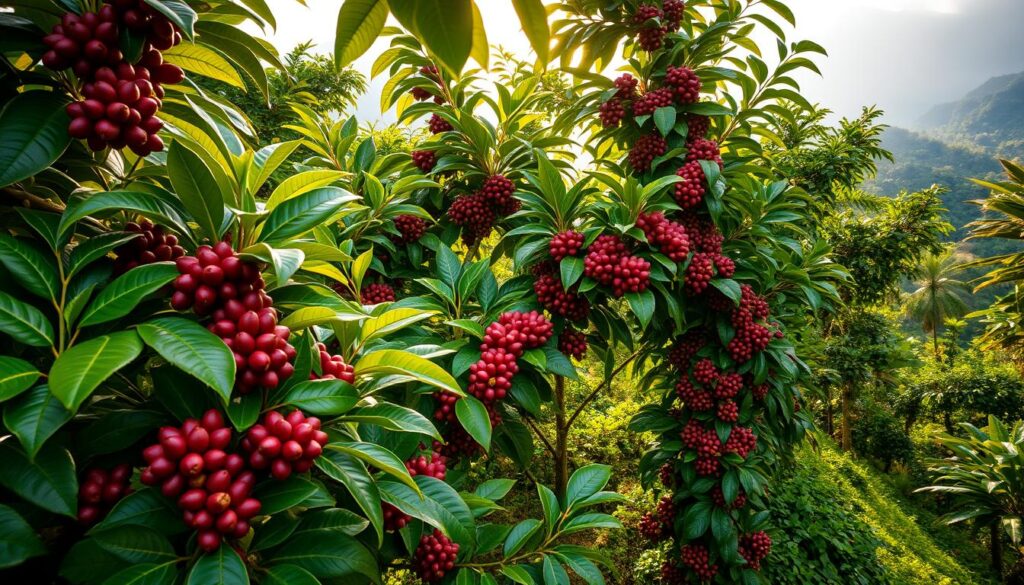
Sumatra is home to five standout coffee varieties. They are known globally for their distinct flavors.
- Mandheling Coffee: Known for its rich flavor and full body
- Gayo Coffee: Has a fragrant aroma and natural sweetness
- Lintong Coffee: The premium variety with an earthy taste
- Lampung Coffee: Offers a bold taste with smoky notes
- Sidikalang Coffee: Provides a smooth flavor with chocolate and spice notes
The Importance of Coffee Bean Types
Knowing about coffee varieties is key. Each variety has its own unique taste, aroma, and drinking experience. Mandheling coffee, for example, is known for its low acidity and smooth finish.
Arabica vs. Robusta: A Quick Overview
“Not all coffee is created equal” – A truth that rings specially true for Sumatran coffee varieties.
Sumatra grows both Arabica and Robusta beans, but Arabica is the main star. The main coffee-producing areas in Sumatra focus on growing these exceptional beans. They showcase the island’s rich agricultural history.
For those who love coffee, Sumatran coffee offers a unique journey. It’s a chance to experience different flavors, traditional methods, and a legacy of top-notch coffee production.
Characteristics of Arabica Coffee
Exploring coffee, I’m excited to dive into Arabica coffee’s unique qualities. These beans are special, known for their exceptional traits and delightful taste.
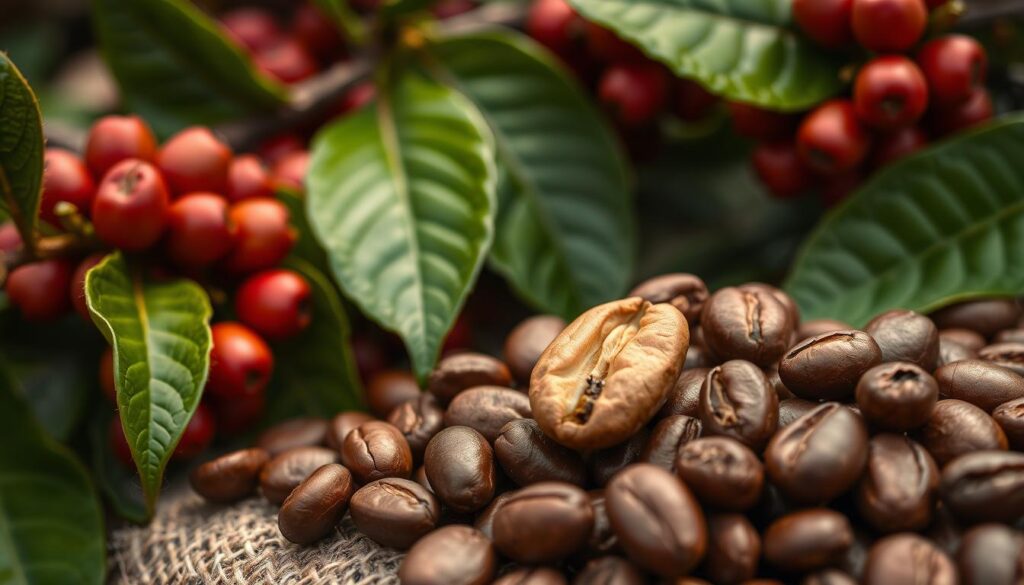
Arabica coffee is a true gem in the coffee world. It makes up about 48% of global coffee production. Coffee lovers adore its sophisticated taste.
Flavor Profile of Arabica
The flavor of Arabica coffee is diverse and complex. It often includes:
- Delicate and complex taste notes
- Hints of fruit, berries, and sometimes floral undertones
- Lower caffeine content (around 1.5%)
- Rich lipid profile with nearly 60% more lipids than other varieties
“Arabica coffee is like a fine wine – complex, refined, and always fascinating.”
Ideal Growing Conditions
Research shows that high-altitude regions are perfect for Arabica plants. These trees grow 2.5 to 4.5 meters tall. They need specific conditions to thrive:
- Elevation between 1,000 to 2,000 meters above sea level
- Temperatures ranging from 60-70°F (15-21°C)
- Volcanic or rich, well-draining soils
- Consistent rainfall and moderate climate
These factors help create the exceptional flavor and quality of Arabica coffee. This makes them highly valued in the global market.
Characteristics of Robusta Coffee
Robusta coffee is a unique and robust coffee variety. It has traits that make it different from Arabica. As a coffee lover, I’ve learned about its amazing qualities.
The traits of Robusta coffee are fascinating. It has about 2.7 percent coffee caffeine, more than Arabica’s 1.5 percent. This means it has a stronger and bolder taste.
Flavor Profile of Robusta
Robusta coffee has a unique taste. Its flavor is:
- Strong and often harsh
- Earthy and woody undertones
- Occasionally with a slight rubbery taste
- More bitter compared to Arabica beans
“Robusta coffee is like the bold character in the coffee world – intense, unapologetic, and full of character.”
Ideal Growing Conditions
Robusta is remarkable for its adaptability. It grows well in low-altitude areas:
- Grows from sea level to about 800 meters elevation
- Tolerates hot and humid climates
- More resistant to pests and diseases
- Suitable for tropical regions like Vietnam and parts of Africa
While Robusta might not be the most refined coffee, its resilience and strong character make it an essential part of the global coffee landscape.
How Sumatra Coffee Differs
Sumatra’s coffee world is full of unique flavors and old processing ways. Exploring this amazing coffee-growing area shows a rich mix of farming practices. These practices make Sumatran coffee stand out from others around the world.
Distinctive Growing Regions
The island’s coffee-growing spots are truly amazing. Key areas include:
- Aceh (home to renowned Gayo coffee)
- North Sumatra (Lake Toba region)
- West Sumatra (Solok, Agam, Pasaman districts)
- South Sumatra
Unique Sumatran Coffee Processing
What makes Sumatran coffee special is its unique wet-hulled coffee processing. This method, known as Giling Basah, gives coffee a special taste that fans love.
The Giling Basah method transforms ordinary coffee beans into something extraordinary.
Sumatran coffee processing has unique steps:
- Crude depulping of coffee cherries
- Overnight fermentation in plastic sacks
- Partial drying on patios
- Selling to middlemen who remove the parchment layer
This process results in coffee with a rich body, low acidity, and an earthy taste. Most Sumatran coffees grow between 2,500 and 5,000 feet. The Gayo Highlands produce some of the best beans.
Is Sumatra Coffee Primarily Arabica or Robusta?
Sumatra’s coffee scene is a mix of Arabica and Robusta, showing the island’s rich coffee history. Its varied geography makes it a top spot for coffee lovers and experts.
The Dominant Coffee Type
Sumatra grows both Arabica and Robusta, but it varies by region. Robusta is more common in the south, like Lampung and Bengkulu. Northern Sumatra, on the other hand, is famous for its Arabica.
- Northern regions (Aceh, North Sumatra): Primarily Arabica
- Southern provinces: Predominantly Robusta
- Altitude range: 800 to 1,600 meters above sea level
The Blend of Varieties
Sumatra’s coffee blends offer a unique taste that stands out. Farmers grow Arabica types like Mandheling and Gayo, each adding its own flavor.
Sumatran coffee is a testament to the island’s rich agricultural diversity and complex flavor profiles.
The wet-hulled method, or Giling Basah, makes Sumatra’s coffee taste even more special. It brings out earthy, herbal, and woody notes that coffee fans love.
The Role of Elevation and Climate
Exploring coffee, we learn how geography affects flavor. Sumatra’s unique terroir makes its coffee stand out. This is why coffee lovers adore its taste.
Sumatra’s volcanic soil is key for coffee. It’s full of minerals and nutrients, perfect for coffee plants. The tropical climate adds more to coffee, shaping the beans.
Impact of Elevation on Coffee Quality
Coffee in Sumatra varies with altitude. The best conditions are:
- Elevation ranges between 800-1,600 meters above sea level
- Slower cherry maturation at higher altitudes
- More developed flavor profiles
- Enhanced natural acidity
Climate’s Influence on Coffee Characteristics
Sumatra’s tropical climate is perfect for coffee. High temperatures and lots of rain make the beans special. These factors add to the coffee’s flavor.
Coffee is not just a beverage—it’s a reflection of its geographical origin.
Knowing these details makes Sumatran coffee even more special. It turns each cup into a journey through the island’s beauty.
Brewing Sumatra Coffee
Sumatra coffee offers a unique and rich experience in coffee brewing. I’ve explored many ways to bring out its full flavor. The smooth, well-balanced body of Sumatran beans requires careful brewing.
The French press method is perfect for Sumatra coffee. It lets the coffee’s low-acid, full-bodied flavors shine. Use a slightly coarser grind and steep for about four minutes to get the deep, earthy flavors.
Pour-over methods also highlight Sumatra coffee’s nuanced flavors. Use a medium-dark roast and focus on water temperature and brewing time. Aim for a balanced extraction that shows the coffee’s natural smoothness and subtle flavors. Try different techniques to find your favorite cup.
Tips for Maximizing Flavor
To enjoy Sumatra coffee, start with freshly roasted beans and filtered water. Sumatran coffee’s unique wet hulling process means it has a short flavor window. Buy beans roasted within the past few weeks. Grind the beans just before brewing for the most vibrant flavors and aromas.
My Favorite Brewing Methods
While French press is my favorite, I also love pour-over brewing. Each method brings out different aspects of Sumatra coffee. Whether you choose French press or pour-over, take your time and savor the rich taste of this exceptional coffee.

